
by Sebastián J. Bianchi
When Hitler was appointed German Chancellor in 1933, it was on his immediate agenda to consolidate his power. Having accomplished this through a series of political moves and strong arm tactics, his next goal was to rebuild the Armed Forces. Here he found himself in a conflicting situation; it was impossible to rebuild the Wehrmacht without breaking the Versailles treaty, but this could not be safely done without a way to defend Germany in case of a response from the Western Allies. Hitler took a chance; He tore up the Versailles treaty and began to strengthen the Armed Forces. He reinstituted Military drafting in March 1935, took control of the Rhineland in 1936, and sent legions of men to Spain to fight along General Franco and be trained on the art of modern warfare.
Germany began to excerpt diplomatic pressure with military threats to annex territories. The Allies, wishing to avoid war at almost any cost, stood idly by when Austria was annexed, gave in to his demands in Czechoslovakia, and allowed the return of the Memel district. The "peaceful" expansion process culminated only with the invasion of Poland, when France and England declared war on Germany and War World II began.
A series of Medals, known as the "Flower War medals", were created to commemorate the three historic occupations. They are not of great monetary value and many collectors do not give them shelf space. They commemorate, however, the troubling road that led to war, and they eventually marched into battle with the men who took place in these event.
The March 13, 1938 Commemorative Medal
(Die Medaille zur Erinnerung an den 13. Marz 1938)
Instituted on May 1, 1938, the medal commemorated the return of Hitler’s homeland to the German Reich. The move was the first in Hitler's quest for "Lebenraum", and it strengthened German flanks while weakening those of Czechoslovakia. German troops crossed the border on March 12, 1938, without meeting any resistance. The stage had been set by a series of "incidents" provoked by National Socialists in Austria, and diplomatic pressure and ultimatums set forth by the German Government. This first action, while perhaps raising suspicions, did not cause general alarm in the world community. After all, it seemed to be done by choice of the Austrian people who were German speaking.
The medal, known as the first "Anschluss medal", was awarded to all those Austrians who contributed to or participated in the annexation as well as the members of the Austrian NSDAP. It was also awarded to German State officials and members of the German Wehrmacht and SS who marched into Austria.
The March 13, 1938 Medal was based on the 1938 Party Day Badge. On the obverse it featured a tall standing figure holding a swastika banner (Germany) helping another figure who had broken shackles (The freed Austrians) onto a podium stand which had the Wehrmacht Eagle and represented the Greater German Reich (all three "Flower War" Medals had the same obverse). On the reverse center it had the inscription "13 Marz 1938" with the slogan "Ein Volk, Ein Reich, Ein Fuhrer" (One people, One State, One Leader) surrounding it. This was a favorite propaganda slogan that had much appeal and it was used repeatedly in Hitler’s speeches to represent the unification attitude of the time.
 |
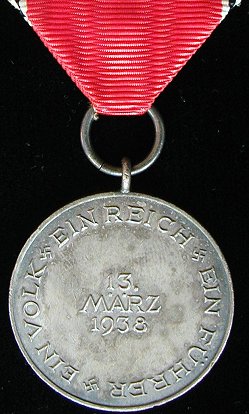 |
Sebastián Bianchi Collection |
|
This Medal was dye struck, which gave it smooth edges and a high degree of detail. It was produced from brass or tombakbronze in with a mat silver finish. The ribbon that held it was red with white-black-white edges. Presentations stopped on December 13, 1940, at which time 318,689 had been awarded.
When worn it was placed as part of a group for formal occasions, or in a ribbon bar for active duty individuals.
The October 1 1938 Commemorative Medal
(Die
Medaille zur Erinnering an den 1 Oktober 1939)
The Medal commemorating the return of the Sudentenland to Germany was authorized on October 18, 1938. Once again Hitler employed skillful diplomacy, using brinkmanship as a dangerous tool to bring the Sudenteland under German control and paving the road for the annexation of Czechoslovakia.
The Sudetenland is a historical region comprising areas of the provinces of Bohemia and Moravia, in the vicinity of the Sudeten Mountains. Though mostly German speaking, following Word War I the treaty of St. Germain incorporated the area into the Czechoslovakian Republic. This had caused deep resentment in Germany, and a point of contention between Germany and Czechoslovakia. Throughout the 1930’s, economic troubles and unemployment drove many to the pro-German stance of Konrad Henlen and his cohorts, who founded the Sudeten German (Nazi) Party. In the summer of 1938, Hitler voiced support for the demands of the German population of the Sudentenland to be incorporated into the Reich. This grew to outright demand from Hitler to annex the area, and threatened war against the advice of his Generals who were sure Germany was not ready to stand up in a World War. Czechoslovakia mobilized, realizing that most of their fortifications and their natural barriers were on their borders and losing these would leave them defenseless. It was under these circumstances that the Munich Conference was held.
Present in Munich on September 29 were Neville Chamberlain (England), Eduard Daladier (France), Mussolini (Italy), as well as Hitler and Ribbentrop. Representatives of Czechoslovakia and the Soviet Union were not invited. The Conference lasted two days, fearing another war and in the most infamous case of appeasement, the Sudetenland was turned over to Germany. In the end, approximately 10,000 square miles and 3,500,000 persons joined the Reich. Chamberlain held the treaty upon reaching England and boasted that they had achieved "Peace in our time". On March 16 1939, Hitler was in Prague proclaiming that Czechoslovakia no longer existed.
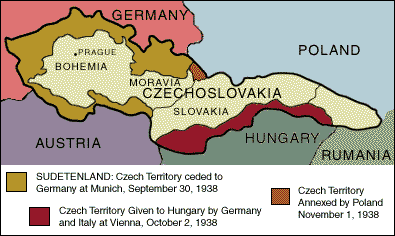
The Medal commemorating these events featured the same obverse as the “March 13, 1938” Medal, and the reverse only differed in the date (October 18, 1938). It was presented to all those who participated in the annexation, as well as the troops who marched into the Sudentenland. It was also presented to all those who later participated in the creation of the protectorates of Bohemia and Moravia.
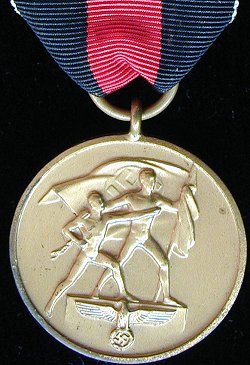 |
 |
Sebastián Bianchi Collection |
|
For those who had received the Medal and took part in those events, a bronze Bar was approved on May 1, 1939. This Bar featured the Prague Castle on the obverse with two triangular prongs in the back, which held it on the ribbon. Both the Medal and the Bar were dye-struck and high in detail, with a Bronzed finish. The ribbon that held it was black-red-black with white borders. Awarding of the medal was stopped on December 1, 1939, with a total 1,162,617 medals and 134,563 Bars presented.
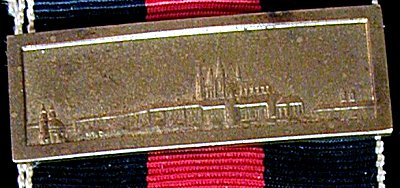 |
 |
Sebastián Bianchi Collection |
|
When worn it was placed as part of a group for formal occasions, or in a ribbon bar for active duty individuals (a miniature Prague Castle bar was place on the ribbon for those who held this award).
The Return of Memel Commemorative
Medal
(Die Medaille zur Erinnerung an die Heimkerhr des Memllander)
In one final bloodless action before World War II, Germany annexed the District of Memel from Lithuania on March 22 1939. This area of East Prussia, with 160,000 inhabitants, had been turned over to Lithuania as an aftermath of World War I following the Memel Convention of 1924. On March 20th, 1939 Hitler demanded that the area be returned to Germany and surprisingly, the Lithuanian government agreed. On March 23rd a peaceful occupation of the city and district was carried out by German troops who debarked by ship. The area was to be on the spotlight two further times in the coming years. It played key role in the Polish campaign, and in the final battles of the war when it was stubbornly defended by German troops.
To commemorate the occupation the "Memel Medal" was authorized on May 1, 1939. This, the last of the Anschuluss awards, was also designed by Dr. Klein. The obverse is the exactly the same as the above medals. The reverse reads “Zur Erinnerung an die Heimkerhr des Memellandes 22. Marz, 1939 (to commemorate the return of the Memel area on March 22,1939), surrounded by an Oak Leave wreath. The award was presented to all military, political and civil Personnel who had distinguished themselves in actions related to the returning of the district to Germany.
The medal was dye stuck with a bronzed finish and worn on the left tunic pocket suspended from a white-red-white-green-white-red-white ribbon, which are the colors of Lithuania. Awards stopped at the end of 1940, with a total of 31,322 having been presented.
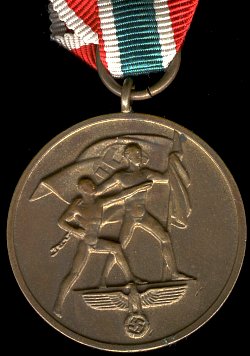 |
 |
Sebastián Bianchi Collection |
|
As with the previous medals, it was worn as part of a group on formal occasions and on a ribbon bar for daily or field wear.
![]()
© Copyright Wehrmacht-Awards.com LLC |